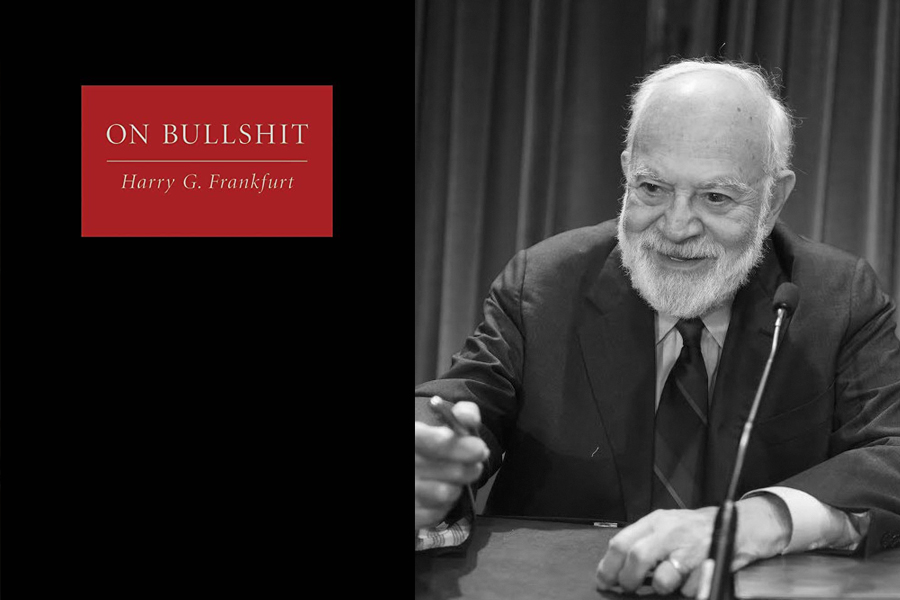President’s Report • Tim Shively • FA President
 In his infamous essay and now best-selling book On Bullshit, Princeton Philosophy Professor Emeritus Harry Frankfurt questions why the titular phenomena is so prevalent in our society and proceeds to systematically delineate its various parts of speech, usage, etymology and sociohistorical contexts. One of the more instructive sections of his text involves the distinction between “lying” on the one hand and “bullshitting” on the other. As Frankfurt puts it,
In his infamous essay and now best-selling book On Bullshit, Princeton Philosophy Professor Emeritus Harry Frankfurt questions why the titular phenomena is so prevalent in our society and proceeds to systematically delineate its various parts of speech, usage, etymology and sociohistorical contexts. One of the more instructive sections of his text involves the distinction between “lying” on the one hand and “bullshitting” on the other. As Frankfurt puts it,
What bullshit essentially misrepresents is neither the state of affairs to which it refers nor the beliefs of the speaker concerning that state of affairs. Those are what lies misrepresent, by virtue of being false. Since bullshit need not be false, it differs from lies in its misrepresentational intent. The bullshitter may not deceive us, or even intend to do so, either about the facts or about what he takes the facts to be. What he does necessarily attempt to deceive us about is his enterprise. His only indispensably distinctive characteristic is that in a certain way he misrepresents what he is up to.
Such is the situation we find ourselves in at present regarding our District’s “efforts” toward salary negotiations. While FA submitted its initial salary proposal on August 2, 2021, before the District had even presented a budget for Board approval, it took them until November to offer us…nothing. In effect, they completely ignored our salary proposal—it really wouldn’t have mattered what we asked for—and built the budget around purposely excluding it. Things have changed since then—they did throw us the crust of making permanent the 2.5% negotiated as a temporary increase back in 2020 and set to expire at the end of this year. And then they took that away, offering instead to keep it temporary for now, and make it permanent in 2022-23. And when it comes to the 5.07% Cost of Living Adjustment (COLA) the District already received in this year’s state budget (what we originally asked for) and the 5.33% in the Governor’s proposed 2022-23 budget (likely to be raised to more than 7% by the time it’s signed, according to Sacramento pundits), they still offer us a big, fat Z-E-R-O. They didn’t even engage in their usual “lowballing” tactic— they “no-balled” us.
Balderdash. That, in essence, is why FA leadership asked our Executive Council to approve a “Work to Contract” (WTC): so that we could, in return, present the District with zero uncompensated labor and make tangible exactly how and how much faculty contribute to keeping this District running. This decision, unanimously approved by the Council, was not taken lightly. In my 30 years employed in the District, this is only the 5th time we’ve invoked WTC, because it is disruptive—to faculty lives, to our students, and of course, to the institution itself. But it is one of few legal means we have at our disposal to make crystal clear our contempt for a District that so little respects its employees that it would completely “sweep” funding made at least partially on our backs (the COLA being based on the elements of the Student Centered Funding Formula, including enrollment and degree completion). The “Work to Contract” works because faculty work together in solidarity to limit the time we spend working on our classes, working with our students, working in shared governance. Looking back at that sentence, that’s a lot of work involved! Basically, any duties we are not contractually obligated to fulfill are fair game (though we must still teach our classes/meet with students, evaluate their work, hold office hours, attend at least 10 Department/Division meetings per year). Typically, a WTC ends pretty quickly. The last one, in 2018, was atypical in that it lasted almost a month. But it’ll end when it ends, which is when we get a legitimate salary offer from the District. What’s “legitimate”? Let’s just say that the District’s last offer of a 4% payment off schedule (i.e. not ongoing) looks pretty piddly against the double digits of the two COLAs added together.
The District’s BS runs pretty deep. While tight purse strings are often viewed as desirable in the management of an institution’s finances, inflexibility is not. A Community College District must remain nimble enough to recognize when there’s a legitimate need to loosen the purse strings, to invest in its employees, particularly when there’s additional money coming into the District. Most of the public (and frankly, probably a good part of the state legislature) is unaware that COLAs do not go directly to our salaries but must be negotiated. Nonetheless, there’s a reason it’s called a Cost of Living Adjustment and not the “Cost of Building Institutional Reserves” (ours are sitting currently at a healthy 17%). You have no doubt heard our District whining about how they can’t compete with the Basic Aid districts which surround us. Granted, West Valley-Mission, San Jose-Evergreen and San Mateo all have more revenue at their disposal. But regardless of how much more they pay their employees, they clearly made their employees a priority to get them to that point. While Foothill-De Anza’s salaries had been in the top three of the “Bay 10” Districts for years, sadly, we have now slipped below the median. And in the face of 8.5% inflation, to say, no, we offer you nothing, with 10%+ additional funding coming into the District, is beyond fiscal conservatism—it is fiscal fascism. To prioritize the institution, and only the institution, so that everything goes to and is for the institution, to the exclusion of the employees’ needs, even when the increased revenue stems from the employees’ labor–‘twould make an Il Dulce proud.
The District, of course, doesn’t operate in a vacuum–we’re located smack dab in the middle of Silicon Valley, which is
looking increasingly like the Berlin of the 1920’s, which precipitated the rise of fascism in Germany: the ostentatious displays of wealth, the growing ranks of the destitute, the insane inflation around the basics of food, shelter, transportation and other necessities. Given the Valley’s median income of $138,000, that makes a good many of us, if not low income, hanging on by our nose hairs. Increasingly employees can no longer afford the basics of living in the larger Bay Area, to say nothing of Santa Clara County. We are moving increasingly further out—to Tracy, Stockton, Fresno, out of the state altogether. We are leaving FHDA for Districts that pay better or are located in less costly areas, or we are quitting education altogether. Our newer and part-time faculty in particular, are forced to move back in with parents, share living spaces with multiple families, or sleep in cars. I’ve heard their stories. And no, it’s not just faculty who are impacted: one of my custodial colleagues is forced to commute daily from Tracy, separately from his wife (who is also an employee), because of the unaffordable rents in the Valley and the District’s inflexibility with his schedule. Certainly, there are also those among us who us aren’t “hurting,” per se, and I’m one of them. Yes, we are saddled with a mortgage, putting two kids through orthodontics with one just about ready for college and juggling two cars between three drivers because of the suddenly inflated cost of buying another. I could complain, but my wife and I together earn enough to own a house (purchased in the depths of the recession), have food in the refrigerator, keep clothes on everyone’s backs and can still afford the occasional family outing. I don’t know how typical that is for tenured faculty in our District (or even if tenured faculty should be considered “typical”), but I thought since I have the example at hand, why not use it.
One of the nonsensical complaints we frequently hear from the citizenry of our service area is how much money those “spoiled” faculty make, which strikes me as rather absurd given how much the titans of the tech industry earn. While it’s true that salary constitutes about 85% of our District’s operating costs, this is based as much on the number of employees as it is the typical salary. Nonetheless, when the District was trying to get Measure “G” passed back in 2020, for example, the local newspapers were full of snarky reader comments citing sources such as “Transparent California” which purport to show the salaries of public employees, and holding up the unusual multi-overload teaching, additional stipend earning and accordingly paid among us as representative of faculty as a whole. Well, since starting in the District back in 1992, I managed to land a full-time gig in 2000, eventually made it to the highest step of the salary schedule (though I’ve been stuck at Column 3), and earned my 4th PAA a couple of years ago, so I thought I’d give it a look. I was surprised at first glance to see a $249K figure at the top of the listings under my name. A closer look revealed that this pertained to Timothy J. Shively, an Officer of the California Highway Patrol. And as far as “Total Pay and Benefits” for CHP Officers go, he’s got almost 40 pages of listings ahead of him. The calculation of “benefits” in these databases is always suspect, however, given local differences. And not knowing where Timothy J. is stationed, rather than go down a bunch of rabbit holes try to figure out how his benefits, overtime and other pay are calculated relative to ours, I zeroed in on his “Regular Pay” of $118,776.42 for 2020. That falls within a range that’s pretty close to instructors who’ve worked in the District for a while, which was somewhat reassuring. I mean, as an English Instructor, I tangle with some pretty dangerous sentences on a daily basis, so it’s good to know that my $103,705 for the same period means we are commensurably compensated. But comparing our salaries to that Silicon Valley median raises some interesting questions about how little value our society places on social services and the rank and file workers who provide them. The disparity is only exacerbated as you consider how few of us remain as you move into higher income levels.
Hooey. Even in a public institution, executive salaries far outpace ours. Apples and oranges some might say, though I would note that both are still fruit. It’s probably no surprise that the Chancellor of a CCC District would earn in excess of $300K base pay (in the case of one “Chancellor Emeritus,” well in excess of $400K), well above the Silicon Valley median, making my $103,705 look pretty paltry. And perhaps that is as it should be, as being responsible for an entire District is a hefty burden. Perhaps, but it’s not just that Executives are paid at a higher salary, but that the opportunities for growth far outweigh those of educators. A Division Dean’s base pay is not that much more than a faculty member, but the opportunity for advancement to higher administrative positions means that they could increase their earnings at a much faster rate than my 14% increase over the period of 2013-2020 (starting from base pay of $90,972), which included my mostly lateral “ascendancy” to the role of FA President. Unless you want to switch to the administrative side of things, there just isn’t much incline for educators: once an instructor, always an instructor—there is no Chancellor of English Writing. Which is why some of us double down on the overloads, summer school, and additional earning opportunities—in order to be able to afford to live here while still teaching.
In the end, the very administrators who oppose our receiving a much deserved and, frankly, necessary salary increase will themselves reap whatever we end up getting. That’s how it works in our District—everyone gets the same increase in the end. Be that as it may, faculty and staff have to do the heavy lifting in removing District obstructions. We have to contend with a Vice Chancellor of Business Services, architect of the District’s “nothing” compensation offer, an interim Vice Chancellor of Human Resources who ostensibly helms the District’s negotiations team and a Chancellor who has the ability to intervene but chooses not to. And, harking back to Frankfurt, we also have a Board of Trustees which, to give them the benefit of the doubt, may not have been presented with an accurate representation of the District’s negotiations. But they’ve heard it being clearly called out now with the work to contract, and we can only hope that they bring the District to its senses before things escalate further. As elected officials, they perhaps have more stake in this than does the administration, particularly as the District’s intransigence becomes more public. They generally like to be seen as being good stewards of the District’s resources and as advancing progressive values. But if you don’t support labor, you certainly aren’t progressive. We welcome them to show us that they do value the work of all the District’s employees by making the changes that need to be made to put an end to this nonsense.




